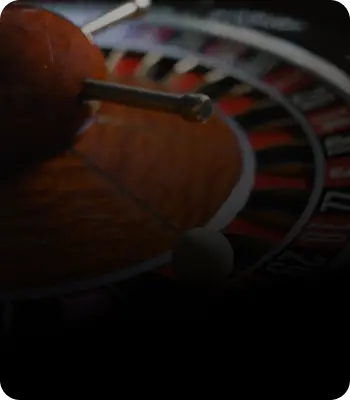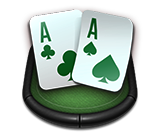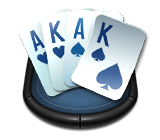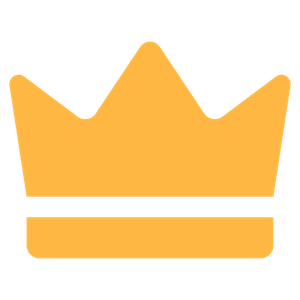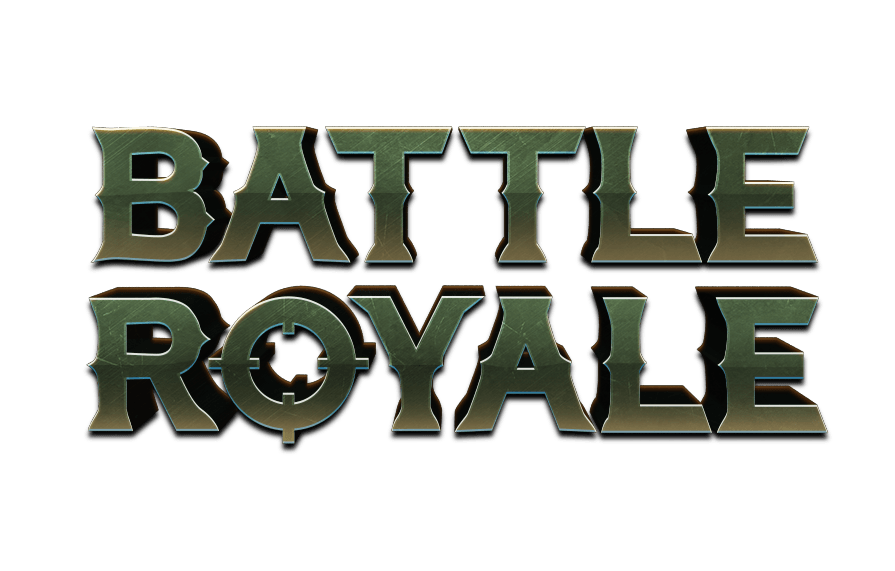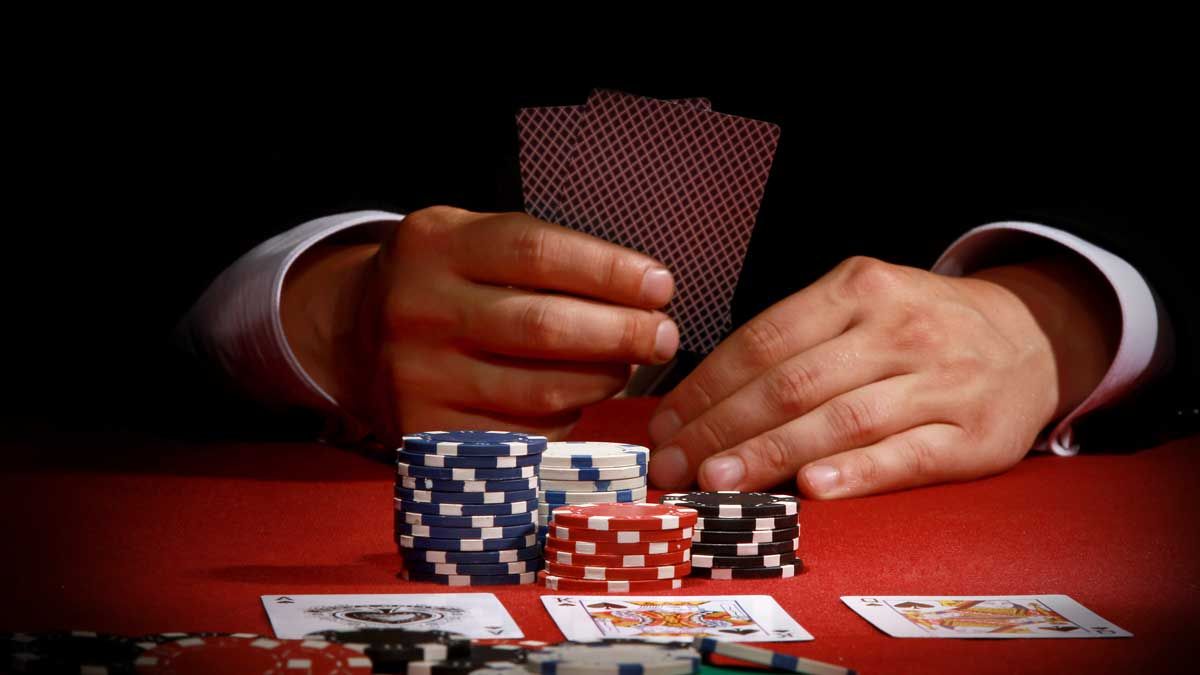
Poker is an incredibly thrilling game that keeps you on the edge of your seat. Even when you hold a strong hand, victory isn't guaranteed. Why? Because you're constantly navigating through a sea of incomplete information, always striving to outsmart your opponents. However, poker is far from being a mere guessing game.
By harnessing a range of tools and knowledge, you can gradually unravel the composition of an opponent's poker range in different situations. Armed with this valuable information, you gain the upper hand to exploit their vulnerabilities when they're most exposed. This strategic advantage can lead to tremendous long-term gains. But before you can accurately predict the cards your opponent holds, it's essential to grasp the concept of poker ranges and how they evolve throughout the game.
What is a Poker Range?
The poker range is a visual collection of all the hands that your opponent might hold in a particular situation. You can create an estimated poker range for every player at your table, letting this dictate how you play.
Poker ranges exist both pre-flop and post-flop, and they even change throughout the hand. Therefore, with every play your opponent makes, you will collect more information to help you refine their range and try to exploit it accordingly.
But how can you possibly visualise what hands your rival might be holding if you haven’t done something like this before? This is where you will check out how poker ranges look in practice for the first time.
Uncovering the Poker Hand Grid
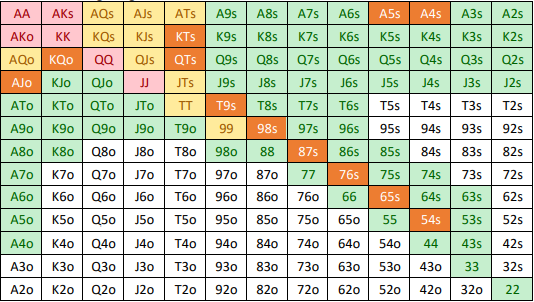 This is how a typical poker range chart looks in practice. This 13x13 grid shows all the possible 169-hand combinations your competition might be holding. The coloured hands are the ones you believe a particular opponent will be playing in a unique situation. As you can see, the playable hands are marked with different colours. This is because each group of combinations will be played differently, depending on its strength.
This is how a typical poker range chart looks in practice. This 13x13 grid shows all the possible 169-hand combinations your competition might be holding. The coloured hands are the ones you believe a particular opponent will be playing in a unique situation. As you can see, the playable hands are marked with different colours. This is because each group of combinations will be played differently, depending on its strength.
Let's say a player is defending a raise versus the button. If he has Q8s, he will probably make a call following his typical range. But if he has a more substantial hand like QTs, you can expect to face a 3-bet, like it's marked with different colours in the poker range grid. On the other hand, all the uncoloured combinations supposedly aren't in your opponent's range, so you can use that to your information later in case you face a flop that includes those missing cards.
For example, if you believe that the poker range of your opponent is tight, in a flop of 7-3-2, he almost won't have any combinations. Thus, making him fold on the flop will be a piece of cake. It's as simple as that, but utilising plays like these brings excellent results over the long run.
Visualise Poker Hand Ranges Easily in Their Different Forms
When playing, you won't have the time to constantly check out various poker hand range grids based on your position at the table. That's why there are a few other ways to help you visualise your opponent's poker ranges, considering the plays he makes. We will go through each of those little approaches in the following lines.
Poker Hand Range in Percentages
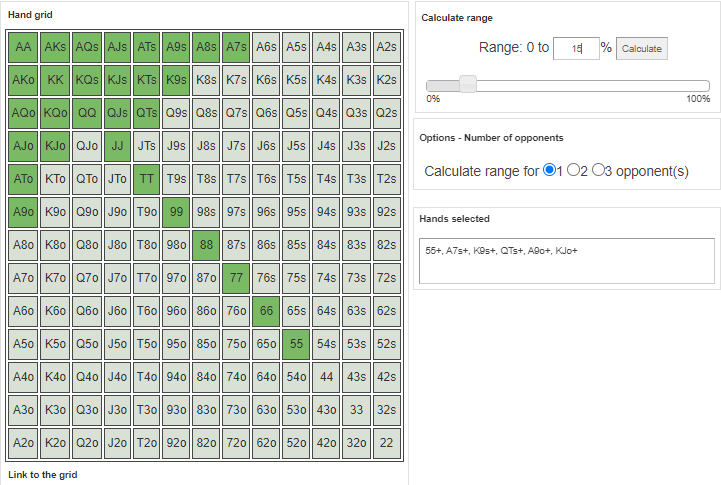 In the picture above, we provided the predicted range for an opponent that plays 15% of his hands. So, if you spot that one of the players on the table tends to be more passive and put in money with much fewer hands, this will mean they are mostly playing a tighter, stronger hand range.
In the picture above, we provided the predicted range for an opponent that plays 15% of his hands. So, if you spot that one of the players on the table tends to be more passive and put in money with much fewer hands, this will mean they are mostly playing a tighter, stronger hand range.
In practice, it will often look like the range above. On another note, if there is someone who plays most of their hands and you deem that their poker play frequency is close to 30%, their range will look more like this: 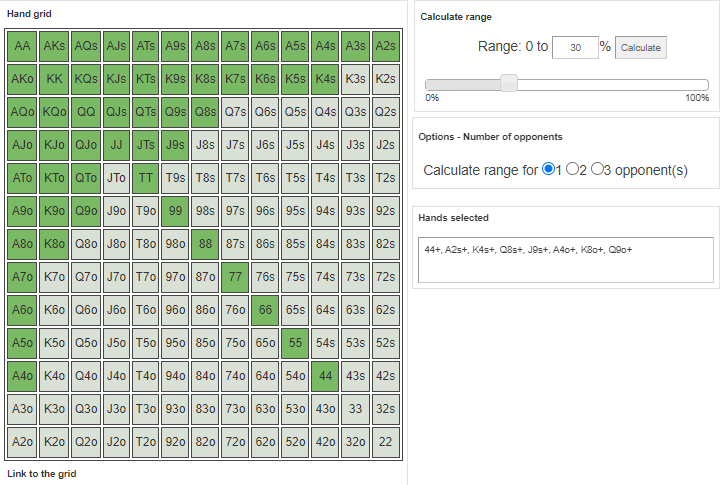 Considering the playing frequency of your opponents, you can pretty much roughly guess the range of hands they are playing. This is how you uncover players’ poker hand ranges by using percentages. And the best thing is you can do this easily in your head while in-game.
Considering the playing frequency of your opponents, you can pretty much roughly guess the range of hands they are playing. This is how you uncover players’ poker hand ranges by using percentages. And the best thing is you can do this easily in your head while in-game.
Range Combos
Looking at some of the poker range charts above, you probably wonder what the “O” and “S” letters mean next to every hand combination. This separates the suited hands from the off-suited combinations.
Suited combinations can bring you many more opportunities for making a flush, which is one of the main reasons you will find most players including more of these hands in their plays and ranges.
Range Strand
Another simple way to memorise poker hand ranges in particular situations is to check out the so-called range strand. This simple line of text illustrates the poker grid at once. For example, here is how this looks on the poker grid.
 The range strand will be more helpful if you can easily remember sentences rather than imaginary pictures or illustrations. But it’s always best to combine all of their forms for even better learning of different poker ranges.
The range strand will be more helpful if you can easily remember sentences rather than imaginary pictures or illustrations. But it’s always best to combine all of their forms for even better learning of different poker ranges.
On top of that, you will find out that in most online poker forums, the range strand is usually how poker ranges are discussed. So if you don’t learn it, you can’t communicate appropriately with all the other experienced players in the forum and take advantage of this.
How to Calculate Poker Ranges?
We briefly covered how you can assume your opponents' poker ranges. But right now, we will dive a bit deeper into this. To correctly guess the range that a particular player is using, you must always pay close attention to every move he makes, and that should be done in as much volume of hands as possible.
By analysing the behaviour of a specific player for a long time, you should be able to spot a few of his tendencies that will help you construct his poker range. There are many ways to do this properly, but the easiest one is to pay attention to the percent of hands he plays and use that to construct his range. Then, you can easily take countermeasures and try to take as many chips as possible, depending on how tight or loose a particular opponent is.
For example, if the player is playing fewer hands, you should always be careful if you decide to play against him, especially when facing big bets on high flops. After all, his range can look pretty scary.
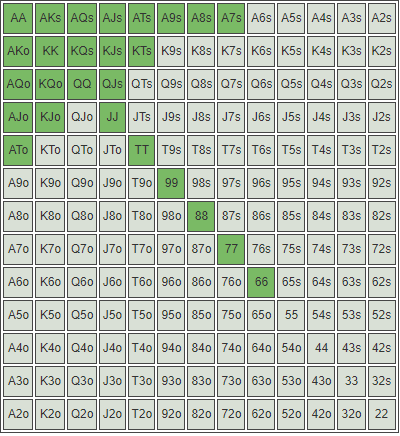 On the flip side, you can always try to bet more and pressure rivals that play more hands. That way, you will generate enough fold equity to be profitable in the long run. And that won’t be too hard to manage versus a typical loose range.
On the flip side, you can always try to bet more and pressure rivals that play more hands. That way, you will generate enough fold equity to be profitable in the long run. And that won’t be too hard to manage versus a typical loose range.
Exploiting Your Opponents’ Poker Ranges
After you are confident to have guessed the poker ranges of a specific opponent, the next step is to think about how you can gain an advantage and, preferably, chips from that information. There are different ways you can do that by involving fancy pot overbetting, re-raise bets, and others. However, the best way to exploit your players' range is to focus on the fold equity you can generate.
You should ask yourself if your opponent is playing too many weak hands. Will those hands often fold on the flop versus a bet? After calling once, will the player have enough value to call again versus a scary overcard on the turn? And how many of those hands will be good enough on the river facing a continuation bet from you?
Once you begin to ask and find answers to those questions, you will be able to put tremendous pressure on your competitors, even with some weaker hand combinations. But it would be best if you also were careful not to over-bluff and try to mix some value hand betting. This brings us to our next crucial point.
Balance Your Own Poker Ranges
Balancing your poker ranges simply means not exposing yourself to risk too much. In the example we mentioned above with the continuation bet, your opponent might have the best possible hand and eventually find out that you had made a few big bets as a pure bluff. This is not a great look and shows a leak in your strategy and ranges.
To avoid scenarios like these, you should carefully examine your opponent's calls versus aggression and know when is the time to give up. Also, you should strive to mix equal amounts of value bets and bluffs into your range, so you can successfully confuse your opposition. If you manage to do this, you will live rent-free in their heads for the whole game, winning quite a few chips along the way.
Where to Go From Here?
Mastering the skill of reading poker ranges is undoubtedly one of the most valuable tools you can use in the game. After all, poker is a game of minimal information and if you learn how to predict your opponents' moves before they happen means you will be winning most of the time.
But learning poker ranges and developing the ability to read every type of player takes considerable time and effort. Like with any other thing, you won't become an expert in poker ranges overnight. But considering the rewards you might reap eventually, it's worth it.













